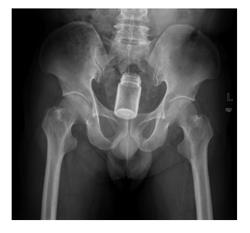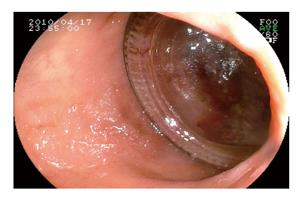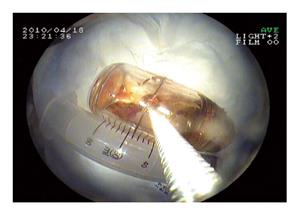Published online May 16, 2016. doi: 10.12998/wjcc.v4.i5.135
Peer-review started: January 21, 2016
First decision: February 26, 2016
Revised: March 8, 2016
Accepted: April 5, 2016
Article in press: April 6, 2016
Published online: May 16, 2016
Processing time: 93 Days and 15.7 Hours
Rectal foreign bodies are man-made injury that occurs occasionally. The management depends on its depth and the consequence it caused. We here report a case of rectal foreign body (a glass bottle measuring about 38 mm × 75 mm) which was located 13-15 cm from the anus. The patient had no sign of perforation, and we managed to remove it using endoscopy with gastrolith forceps.
Core tip: Rectal foreign bodies happen occasionally. The majority of rectal foreign bodies inserted by adults are for self-gratification. As such they are likely to be smooth, rounded, cylindrical, or egg shaped to allow ease of introduction and removal. The factors that determine whether a rectal foreign body can be removed transanally are the shape, size, location of the object, and the presence or absence of perforation. We here report a case of rectal foreign body (a glass bottle measuring about 38 mm × 75 mm) which was located 13-15 cm from the anus. The patient had no sign of perforation, and we managed to remove it using endoscopy with gastrolith forceps.
- Citation: Lin XD, Wu GY, Li SH, Wen ZQ, Zhang F, Yu SP. Removal of a large foreign body in the rectosigmoid colon by colonoscopy using gastrolith forceps. World J Clin Cases 2016; 4(5): 135-137
- URL: https://www.wjgnet.com/2307-8960/full/v4/i5/135.htm
- DOI: https://dx.doi.org/10.12998/wjcc.v4.i5.135
The majority of rectal foreign bodies inserted by adults are for self-gratification. As such they are likely to be smooth, rounded, cylindrical, or egg shaped to allow ease of introduction and removal. The factors that determine whether a rectal foreign body can be removed transanally are the shape, size, location of the object, and the presence or absence of perforation. We here report a case of rectal foreign body (a glass bottle measuring about 38 mm × 75 mm) which was located 13-15 cm from the anus. The patient had no sign of perforation, and we managed to remove it using endoscopy with gastrolith forceps.
A 40-year-old male was admitted due to retention of a large foreign body in the rectal colon (Figure 1). He put a glass bottle into his anus in his self-sexual play 3 d before admittance. On physical examination, a cylindrical shape glass plat about 4 cm in diameter could be touched in the rectal touch 4 cm from the anus. Plain abdominal radiograph revealed a bottle shape foreign body (measuring about 38 mm × 75 mm) retained in hypogastric zone adjacent to pubic symphysis, without sign of perforation. The open of the bottle was in the proximal region of the colon, and the basal of the bottle was near the anus, which made it difficult to remove by anal speculum. The bottle slid into the rectosigmoid colon deeper during the procedure (Figure 2). We decided to have a colonoscopy as a last method before cutting him open. In the colonoscopy, it was found that a wide basal glass bottle filled the colon 15 cm from the anus. The use of snare and basket failed to noose the bottle (Figure 3). We decided to use gastrolith forceps to noose the bottle. After full gas filling, we were able to noose the basal part of the bottle. The patient felt painful, so lumbar anesthesia was performed to relieve the spasm of the colon and pain. The bottle was carefully and slowly dragged to the open of the anus, and it was successfully removed outside the patient by colonoscopy. There was no sign of bleeding, injury or perforation in the post-extraction sigmoidoscopy and 2 d observation following. Then the patient was discharged. The patient had no perforation, bleeding or fecal incontinence during one-month follow-up.
The majority of rectal foreign bodies inserted by adults are for self-gratification[1]. As such they are likely to be smooth, rounded, cylindrical, or egg shaped to allow ease of introduction and removal[2]. The factors that determine whether a rectal foreign body can be removed transanally are the shape, size, location of the object, and the presence or absence of perforation[2]. In the non-perforated stable patient, the object should be removed with a local block and/or conscious sedation via the transanal approach. If this fails, the patient should be brought to the operating room for a deeper anesthetic and attempt at transanal extraction. Surgery with a laparotomy should be reserved for patients with perforation or ischemic bowel or cases of failed transanal attempts[3]. Most of rectal foreign bodies can be removed transanally, but when they go deeper to the sigmoid colon, it is impossible to extract except via colonoscopy[4]. In our patient, the basal, smooth, large part of the bottle was in the distal colon, which makes it much difficult to remove out. We used gastrolith forceps to loop the bottle, and seized it tightly enough to extract.
A 40-year-old male presented seeking for medical help due to rectal foreign body insertion.
Rectal foreign body (glass bottle) insertion.
Bowel perforation, intestinal necrosis, and foreign body rupture.
A bottle shape foreign body (measuring about 38 mm × 75 mm) retained in hypogastric zone adjacent to pubic symphysis, without sign of perforation.
Rectal foreign body (glass bottle).
Removed using colonoscopy.
Foreign bodies of different shapes were reported, little smooth ones can be removed via a transanal approach while irregular shape ones needed to be surgically removed.
RFB: Rectal foreign bodies.
For removal of rectal foreign bodies via a transanal approach, relaxation of patients and full dilation of the anus are very important.
This is an interesting case and the X-ray imaging showed a typical rectal foreign body. Anesthesia before retreating the foreign body should be considered.
P- Reviewer: Day LW, Saligram S, Verma M S- Editor: Qi Y L- Editor: A E- Editor: Liu SQ
| 1. | Irizarry E, Gottesman L. Rectal sexual trauma including foreign bodies. Int J STD AIDS. 1996;7:166-169. [RCA] [PubMed] [DOI] [Full Text] [Cited by in Crossref: 8] [Cited by in RCA: 8] [Article Influence: 0.3] [Reference Citation Analysis (0)] |
| 2. | Singaporewalla RM, Tan DE, Tan TK. Use of endoscopic snare to extract a large rectosigmoid foreign body with review of literature. Surg Laparosc Endosc Percutan Tech. 2007;17:145-148. [RCA] [PubMed] [DOI] [Full Text] [Cited by in Crossref: 24] [Cited by in RCA: 24] [Article Influence: 1.3] [Reference Citation Analysis (0)] |
| 3. | Goldberg JE, Steele SR. Rectal foreign bodies. Surg Clin North Am. 2010;90:173-184, Table of Contents. [RCA] [PubMed] [DOI] [Full Text] [Cited by in Crossref: 72] [Cited by in RCA: 76] [Article Influence: 5.1] [Reference Citation Analysis (0)] |
| 4. | Coskun A, Erkan N, Yakan S, Yıldirim M, Cengiz F. Management of rectal foreign bodies. World J Emerg Surg. 2013;8:11. [RCA] [PubMed] [DOI] [Full Text] [Full Text (PDF)] [Cited by in Crossref: 65] [Cited by in RCA: 62] [Article Influence: 5.2] [Reference Citation Analysis (0)] |















